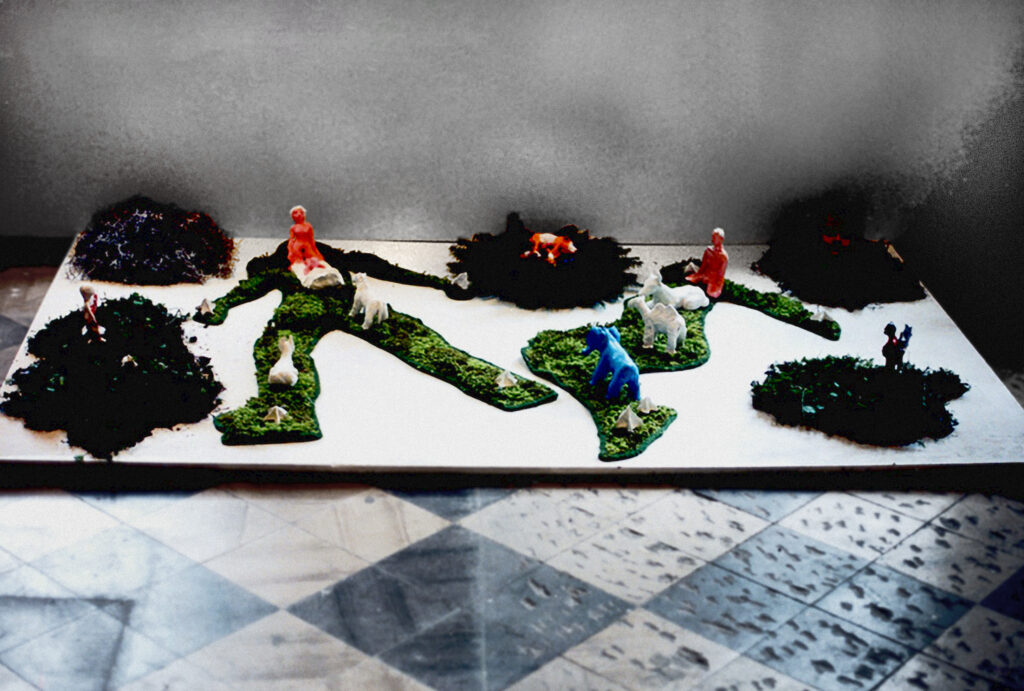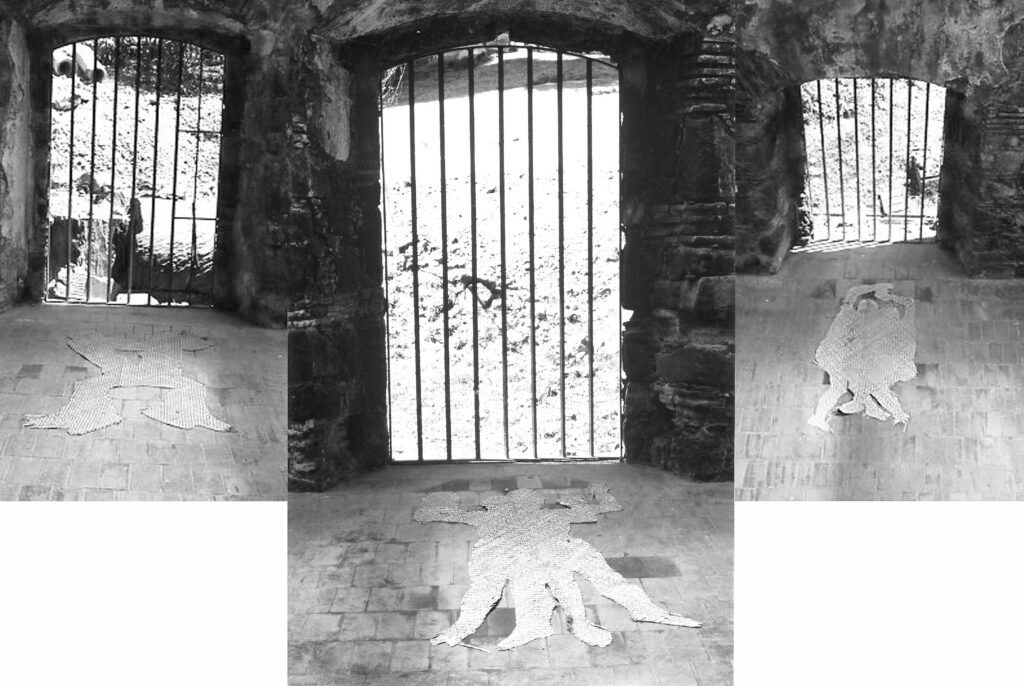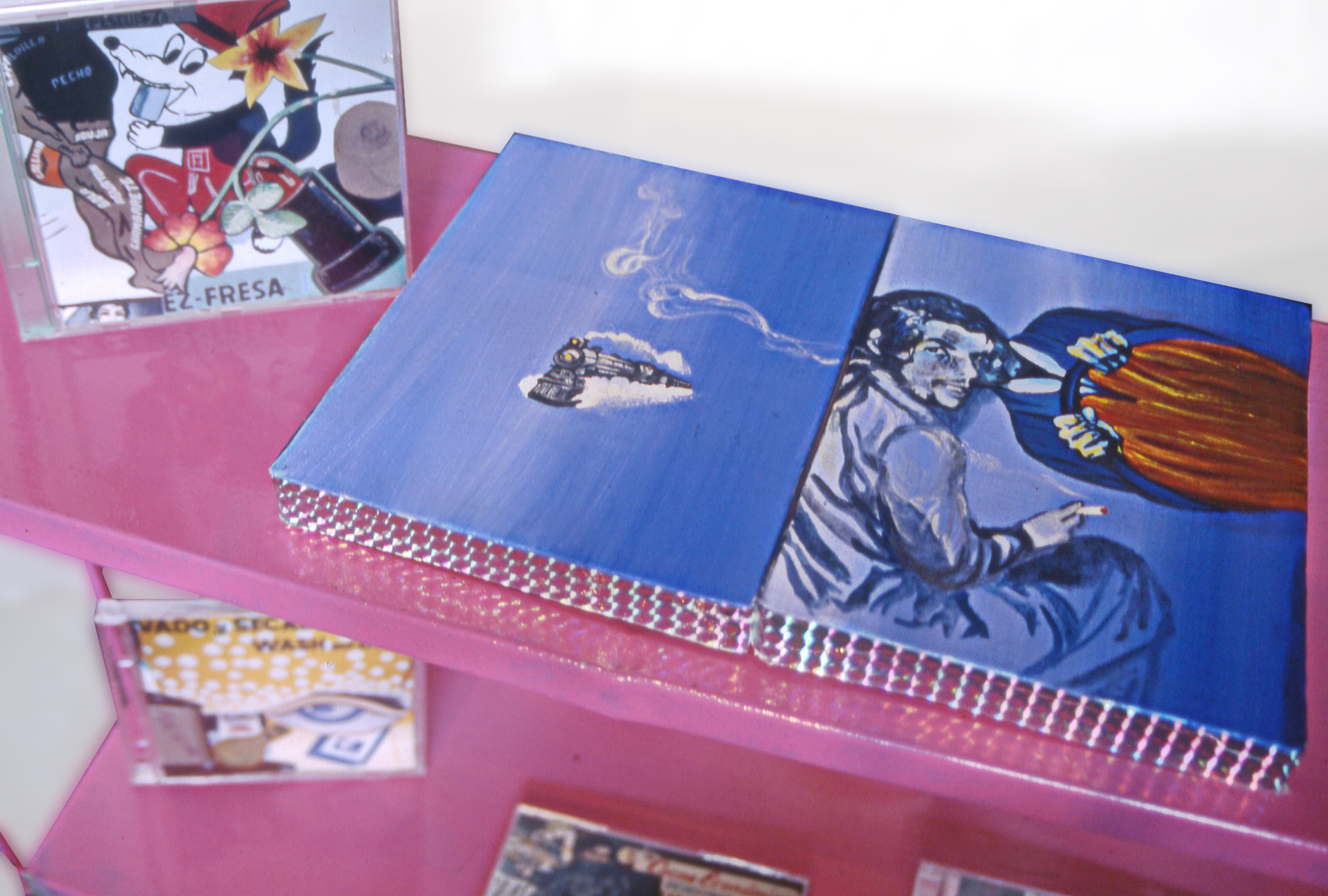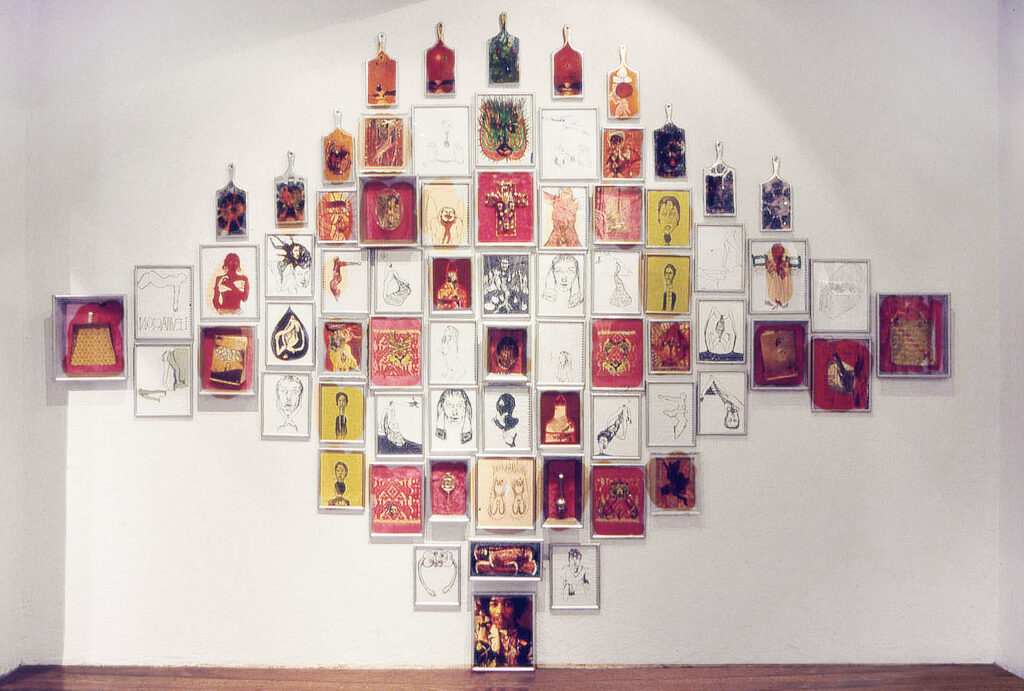La Peña Cultural Center, Berkeley, California
04.12. 1997
Artist: Marisa Cornejo
Curated by: Alfonso Jaramillo
Venue: La Peña Cultural Center, Berkeley, California, USA
Date: December 1997

Research artist in the fields of memory, identity and migration
Artist: Marisa Cornejo
Curated by: Alfonso Jaramillo
Venue: La Peña Cultural Center, Berkeley, California, USA
Date: December 1997

Title: Nacimientos navideños. Hechos por artistas de Vanguardia
Artists: Pablo Vargas Lugo, Katia Duregon, Miguel Calderón, Artemio, Adriana Días de Cossio, Marisa Cornejo, Joshua Okon, Taca, Daniela Rossel and Rodrigo Aldana
Venue: La Panadería, Amsterdan 159, Col. Condesa, México D.F., México
Date: 17 December 1997

Solo show: Viernes 13
Artist: Marisa Cornejo
Curator: Keith Miller
Venue: La Obra, Puebla, México
Date: June 1997
La muestra de Marisa Cornejo, lúdica y alejada del poder
by Marco Rodríguez Alcaraz, in La Jornada de Oriente
Una expresividad alejada del poder y lúdica manifiesta Marisa Cornejo en su exposición denominada Viernes 13, que se presenta hasta mediados de julio en el café La Obra.
Esta es su primera exposición individual y en la ANGELOPOLIS. Sus exposiciones colectivas suman 19 y las ha presentado casi en su totalidad en la ciudad de México (donde ha hecho sus estudios de artes plásticas), a excepción de la presentada en Guadalajara, Jalisco.
Mujer en movimiento desde que se vio exiliada de su tierra natal, Chile, acompañó a sus padres en el transito por Argentina, Bulgaria y Bélgica, hasta llegar a México y por ende a Puebla, en donde radica desde los nueve años.
En relación con el nombre de su exposición, Marisa dijo a este diario que fue incidental: « Cony Carbajal, responsable del foro, propuso el 12 y yo elegí el 13, porque se vincula con el tema que desarrollé en mi tesis de licenciatura. »
Asocia el número 13 a la cantidad de meses que tenían los calendarios lunares, de 28 dias cada uno, y que implican los ciclos fértiles de la mujer. »
Marisa hace una distinción entre poder y fuerza, el primero se impone y la segunda sólo se mani-fiesta.Además, complementa, hombre y mujer expresan fuerza de manera distinta: « Si yo quisiera expresarme como hombre me! debilitaría », concluye.
Cincuenta y dos piezas trabajadas en forma independiente, aunque algunas se integran para conformar una más amplia, dan cuenta de alguien que disfruta lo que hace y lo hace con los elementos a : su alcance aunque éstos sean mínimos y despojados de todo intento de trascendencia
Dos fragmentos de una pintura compuesta por siete en diferentes tonos de azul, integra la figura del Che fumando, el Popocatépetl con su cráter llameante, los labios de éste como un volante de auto y sobre él, unas manos que lo conducen —opuesta al cono del cráter se encuentra el torso del hombre que conduce el volante-; el humo que genera el cráter y el cigarrillo del Che pasan al siguiente fragmento y del vértice que forma el humo surge portentosa una pequeña locomotora.
Installation: Modulo de información, collection of photoraphs on cilinder, 160x250cm, 1997
Exhibition: Diálogo México-Tijuana
Artists: Marisa Cornejo, Saúl Cortéz, Andrea Ferreira, Jonathan Hernandez, Rocío Ortega y Vicente Razo
Venue: Centro Cultural de Tijuana, Tijuana, México
Date: November 1997

Artists: Marisa Cornejo, María Ezcurra and Mariana Gulco
Curated by: María Ezcurra
Venue: Centro Cultural Contreras, México D.F., México
Date: March, 1997

Title: No toda, paintings
Exhibition: Espacios imaginarios
Artists: Marisa Cornejo and Mariana Gulco
Curated by: Itala Schmeltz
Venue: Facultad de Filosofía y Letras, UNAM, México City, México
Date: March 1997
No toda, Marisa Cornejo
Venus, como las perlas, nace de una concha marina y la espuma del mar despierta en ella su sensualidad viajera. Venus recorre, con su percepción, los reinos de lo sensible. Su cuerpo es vegetal, es caracola, es ave, es la humareda del tren que vimos pasar, o el atardecer surcado por un helicóptero. Venus, en la obra de Marisa, es la gracia y la belleza que dejan los espacios vividos en nuestra percepción sensible. — Itala Schmeltz
Not All, Marisa Cornejo
Venus, like pearls, is born from a seashell, and the sea foam awakens her wandering sensuality.
With her perception, Venus travels through the realms of the sensuous.
Her body is plant, is seashell, is bird, is the smoke of the train we saw go by, or the sunset crossed by a helicopter.
Venus, in Marisa’s work, is the grace and beauty left behind by lived spaces in our sensitive perception. — Itala Schmeltz
Artist: Marisa Cornejo
venuee: Artist studio,
Licenciado Verdad, Centro Histórico, Mexico City, México
Date: 29.11.–01.12.1996
After having a dream where I was headless I decided to do a project where asked friends, neighbours, family members and colleagues to make a portrait of myself. This project became my degree thesis called Multifacetica, making a link between my dream and various myths of decapitated goddesses. I exhibited this drawings in my studio with other related works before my professional exam.
Artists: Artemio, Eduardo Abaroa, Francis Alÿs, Miguel Calderón, Marisa Cornejo, Daniel Guzmán, Jerónimo López (Dr Lakra), Julián Lede, Richard Moszka, Yoshua Okon and Grupo Titan
Curated by: Eduardo Abaroa, Miguel Calderón and Yoshua Okón
Venue: Estancia Infantil Topiltzin, Guadalajara, México
Date: 27–29.09.1996
Esta exposición colectiva es un evento paralelo a la feria de Arte de Guadalajara organizado por La Panadería. En ella, Eduardo Abaroa, Miguel Calderón y Yoshua Okón solicitan al resto de los artistas invitados que utilicen el jardín de niños Estancia Infantil Topiltzin como parámetro conceptual para la elaboración de sus piezas, característica que dota a la exposición de múltiples posibilidades de alterar el orden de los objetos, crear una relación distinta entre forma y significado e intentar una resignificación de los espacios de la escuela.
This group show is an event organized by La Panadería parallel to the Guadalajara Art Fair for which Eduardo Abaroa, Miguel Calderón and Yoshua Okón invited the other artists to use a kindergarten in Guadalajara, Estancia Infantil Topiltzin, as a conceptual parameter for the creation of their work. This allows the exhibitors a multiplicity of possibilities to alter the order of the objects and to create a different relationship between form and signifier and, in this way, to modify the school space.

Title: Limpia: en el arca hay sitio para todos, 350x530cm, 1996
Exhibition: México develado
Artists: Carlos Arias, Pedro Barra, Marisa Cornejo, Roberto Duarte, Alejandro Escribano, Ingrid Fugellie, Oscar Hernández, Cristian Marambio, Claudio Rivera, Edwin Rojas, Eugenia Vargas and Isabel Viviani
Curated by: Claudio Rivera
Documentation: Daniela Rossel
Venue: Centro Cultural Isidro Falabella, Mexico D.F., México
Date: 1996

Title: Juego de alfombras para sala
Exhibition: Hogar dulce hogar
Artists: Rodrigo Aldana, Marisa Cornejo, Miguel Calderón and Saúl Villa
Curated by: Rodrigo Aldana
Venue: La Panadería, México, Mexico
Date: August 1995
Video, photography and installation come together in this show to create a home-like environment. Each artist is assigned a space with a social function and meaning to be used in their piece. Four rugs, each in the shape of a human figure -a Playboy pinup, Spiderman, etc- strategically placed by Marisa Cornejo, create an environment that makes evident the masculine-feminine hierarchies within the home. Miguel Calderón decorates the family room with a wall-sized photomural, two comfortable poufs and two televisions showing the artist’s video work. Saúl Villa decorates the master bedroom -which includes instructions on how to use the bed-. Finally, lighting for the whole space is the work of Rodrigo Aldana, who creates a warm environment for each piece, as well as a text since each lamp includes a short passage on the different artists.
El video, la fotografía y la instalación se conjuntan en esta exposición con la intención de recrear un ambienteshogareño. A cada artista le es asignado un espacio cuyas funciones y significados sociales tienen que ser utilizados para realizar su pieza. Cuatro alfombras, cada una en forma de silueta humana -chica playboy, Spiderman, etcétera- son colocadas estratégicamente por Marisa Cornejo para crear un ambiente de posiciones y rangos masculino-femenino dentro del hogar; el cuarto de televisión decorado con un fotomural, dos cómados puffs y dos televisiones con sus respectivos videos, obra de Miguel Calderón; la recámara principal -dotada de un instructivo para usar la cama- a cargo de Saúl Villa; y finalmente, la iluminación de los espacios a cargo de Rodrigo Aldana, crea una atmósfera envolvente para cada pieza con luz y texto, ya que cada lámpara contiene un pensamiento alusivo al artista cuya pieza iluminaba.